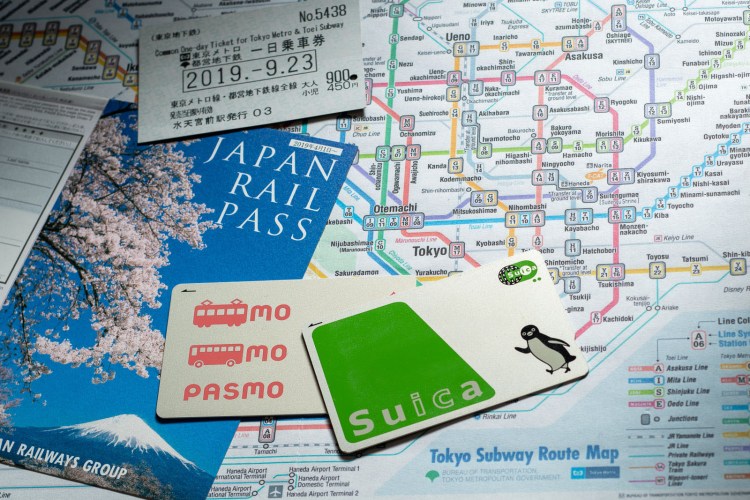What’s the best ticket for Tokyo transportation?

I’m often asked “What is the most efficient way to get around Tokyo by public transportation?”
As a Tokyo local guide, the answer differs depends on your preferences and your itinerary in Japan. I’d like to introduce the basic knowlege about Tokyo transportation and useful tips for travelers in this article.
3 transportation networks in Tokyo

At first, Tokyo has mainly 3 different transportation networks, making it difficult for tourists to understand the system as a whole.
- JR (Japan Railways) – JR operates mainly ground trains and Shinkansen bullet trains throughout Japan.
- Metro – Tokyo’s main subway lines are actually run by 2 different companies.
・Tokyo Metro
・Toei Meto (Toei=Tokyo Metropolitan government Line) - Other Plivate Lines – Examples : Keisei Line for Narita Airport, Keikyu Line for Haneda airport, Yurikamome Line for Odaiba Bay area and more.
My 4 tips for travelers
(1) The most reasonable – Tokyo Subway Ticket

● Tokyo Subway Ticket (24H / 48H / 72H) is recommended for people who want the most reasonable way.
https://www.tokyometro.jp/tst/en/index.html
Best value for visitors, needs passport for purchase, offering unlimited ride during the limited hours. Recommended for those who stay in hotel near Metro stations.
Advanteges :
・The most reasonable with unlimited ride for a certain duration of time.
Disadvantages :
・Only for 2 metro lines in Tokyo Metropolitan district. Not available for JR and other private lines. (However, most major spots are covered by these 2 metro company lines.)
・Need to understand the differences between metros and other lines in Tokyo.
(2) The easiest – Welcome Suica (or PASMO PASSPORT)

●Welcome Suica for travelers is recommended for people who want the easiest.
https://www.jreast.co.jp/e/welcomesuica/welcomesuica.html
Expire after 28days. This is new service for short-stay travelers since Sep 2019.
Advantages :
・No deposit on purchase (unlike normal SUICA).
・No need to return.
・No need for understainding the whole transportaion system.
・Available for most major lines and buses in other major cities as well by just tapping the card.
・Can be used at some convenience stores and some vending machines(drinks).
Disadvantages :
・Expire 28 days after the purchase. (You can bring it back as a souvenir.)
・No refund (unlike normal SUICA).
・Better to spend remaining e-money at available shops such as convenience stores before leaving Japan.
●PASMO PASSPORT
Similar to Welcome Suica. Issued by Tokyo Metro with cute Sanrio character design. Disadvantage is issuing fee of ¥500. For Kitty lovers, recommended as good souvenior.
(3) For repeaters – nomal SUICA or PASMO

● (normal) SUICA or PASMO
Most Tokyoites use either one for daily use. Those are recommended those who are sure to come back to Japan. SUICA is issued by JR East, PASMO is by Tokyo metro. Same function. (ICOKA is JR west)
Advantages :
・Available for most major lines and buses in other major cities as well by just tapping the card.
・Can be used at some convenience stores and some vending machines (drinks).
・Refundable.(When you return it, deposit and remaining e-money will be refunded.)
・Expire date is 10 years from the last use of the card.
Disadvantages :
・Needs deposit (¥500)on purchase.
・You need to return it at certain ticket counters to get money back when you don’t need it anymore.
・After 10 years no use, SUICA will be expired but can be issued again or refunded with handling charge. PASMO will be expired automatically without refund.
(4) How about JR-pass?

One more often asked question is “Can I get around Tokyo by JR-pass?”
Some travelers seem to think that they can get around Tokyo easily by JR-pass without paying extra. Unfortunately it’s not happening here. As I mentioned above, Tokyo has 3 transportation networks, JR, 2 metros and other private lines. JR-pass is only for JR trains. Not available for metros nor other private lines.
Actually 2 metros cover more detailed sightseeing spots than JR, including Asakusa and Tsukiji Market. We take more metros than JR trains for general sightseeing in Tokyo. Your JR-pass will be useful when you visit the places where JR covers in Tokyo.
Now, ready for a new adventure?
My private Tokyo tours might help you understand these systems so that you can get around Japan more freely! Thank you for taking the time to read this article. Waiting for your contact!
Author Profile

- A national government licensed tour guide in English loves to introduce Japanese life with unique photos📸. Mainly Tokyo🇯🇵 and surroundings.






